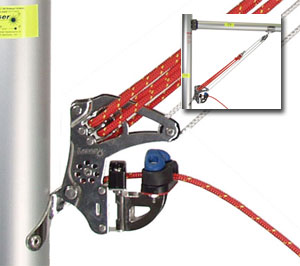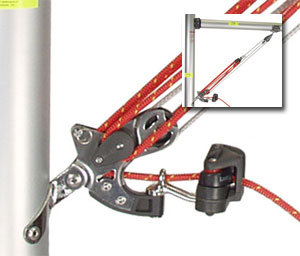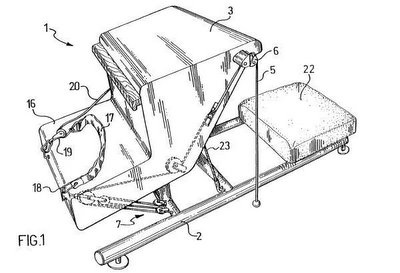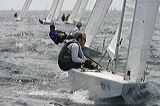There's Harken's version:
 And Holt Allen's version:
And Holt Allen's version:
No shoes, no shirt, no problem.
 And Holt Allen's version:
And Holt Allen's version:
 The PCT application has been designated for regional patents in a bunch of countries, notably the US, New Zealand, Australia and the UK. It has only issued as an actual patent in Australia but it has entered the examination process in the US. Here's an excerpt from the description of the invention:
The PCT application has been designated for regional patents in a bunch of countries, notably the US, New Zealand, Australia and the UK. It has only issued as an actual patent in Australia but it has entered the examination process in the US. Here's an excerpt from the description of the invention: There's no way that I am going to build anything like that.
There's no way that I am going to build anything like that.
 When I was working at the St. Croix Yacht Club as a sailing instructor I met Chris, Scott and Peter Stanton who were local kids with some great sailing talent. Their family was originally from the Jersey shore and the boys regularly cleaned up on the Caribbean J24 circuit in their boat Jersey Devil. While I was teaching at the yacht club, Scott and Peter had managed to find an old 470 that was so soft that you could watch it flex over every wave. The boys were only about 14 years old, but they were incredible sailors. I remember that the boys travelled to regattas in Miami and did acceptably well considering the condition of their boat. Scott Stanton now sails for Texas A&M and Peter sails for Eckerd College. Peter was third (with older brother Chris Stanton as crew) in the 470 at the 1999 Miami OCR and is registered for the 2006 Miami OCR. If I have time I'll follow his results in Miami and post them here.
When I was working at the St. Croix Yacht Club as a sailing instructor I met Chris, Scott and Peter Stanton who were local kids with some great sailing talent. Their family was originally from the Jersey shore and the boys regularly cleaned up on the Caribbean J24 circuit in their boat Jersey Devil. While I was teaching at the yacht club, Scott and Peter had managed to find an old 470 that was so soft that you could watch it flex over every wave. The boys were only about 14 years old, but they were incredible sailors. I remember that the boys travelled to regattas in Miami and did acceptably well considering the condition of their boat. Scott Stanton now sails for Texas A&M and Peter sails for Eckerd College. Peter was third (with older brother Chris Stanton as crew) in the 470 at the 1999 Miami OCR and is registered for the 2006 Miami OCR. If I have time I'll follow his results in Miami and post them here.



 Last summer I sailed on a Star. The nice thing about sailing a Star at the club/regional level is that the boat is not that physically demanding. Some Star sailors might disagree, but it just doesn't take that much effort as a crew to trim the tiny jib, adjust the backstays and droop hike, compared to sailing in smaller dinghies. Sure, the stakes are a bit higher in a Star; if you screw up a gybe in a dinghy you might lose a few places in the race...in a Star, if you forget to cleat the new windward backstay as you cross the boat then the mast will go over the bow. In the Star, I had plenty of strength and enough coordination to do everything I needed to do. It would have been nice to be able to lift myself out of a droop hiking position without using the deck handle (OK...grabbing the backstay) but hiking itself doesn't take much effort in a droop harness. Being a big Star crew was fun, but I need to get back to driving a boat and my most likely ride is a Laser.
Last summer I sailed on a Star. The nice thing about sailing a Star at the club/regional level is that the boat is not that physically demanding. Some Star sailors might disagree, but it just doesn't take that much effort as a crew to trim the tiny jib, adjust the backstays and droop hike, compared to sailing in smaller dinghies. Sure, the stakes are a bit higher in a Star; if you screw up a gybe in a dinghy you might lose a few places in the race...in a Star, if you forget to cleat the new windward backstay as you cross the boat then the mast will go over the bow. In the Star, I had plenty of strength and enough coordination to do everything I needed to do. It would have been nice to be able to lift myself out of a droop hiking position without using the deck handle (OK...grabbing the backstay) but hiking itself doesn't take much effort in a droop harness. Being a big Star crew was fun, but I need to get back to driving a boat and my most likely ride is a Laser.